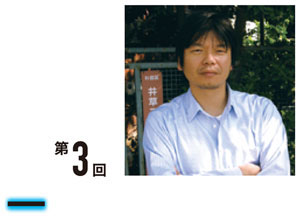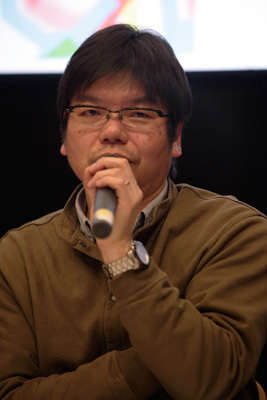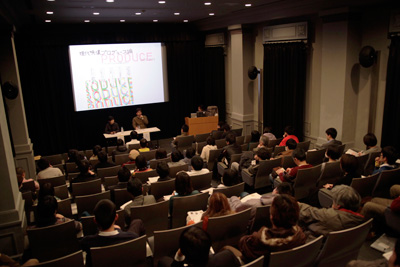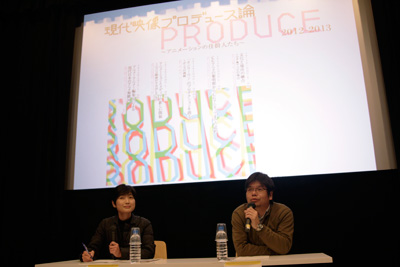Class 3: How to Make a Production Company the One and Only – A Challenge of "BONES"Lecturer: Masahiko Minami, the president of BONES INC.Time & Date: 18:30 - 20:00, February 19th, 2013The class has finished. [ The Archive of the Class ] | |
 Studio BONES[1] is famous for its splendid drawing work and for having created numerous masterpieces, such as Sword of the Stranger and Cowboy Bebop. Since founded to be a production company with backbone, it has shown significant presence in the industry and played the role of leading the new generation of animation. Mr. Minami, who became independent from SUNRISE Inc.[2] and established his original brand, will share his vision and history of bones.  |
|
The Archive of the Class
Mitsuko Okamoto: Today we have with us one of the producers that I respect most, Mr. Masahiko Minami from BONES . Mr. Minami graduated from Osaka University of Arts and worked for an animation studio called SUNRiSE (at the time Nippon Sunrise) where he worked on works like Cowboy Bebop. He became independent in 1998 and established the animation studio BONES. He has worked on numerous famous pieces that you've all heard of as RahXephon , Hagane no Renkinjutsushi (English Title: Fullmetal Alchemist), and Kōkyōshihen Eureka Sebun (English Title: Eureka Seven aka Psalms of Planets Eureka seveN). It will be the company's 15th anniversary this year and today we will ask Mr. Minami, the president of BONES which consistently retains the position of industry leader, about the work of a producer. Can you first tell us why you became a producer and give us some background on why you joined the field of animation? Masahiko Minami: I loved animation from when I was a child and eagerly watched Majingā Zetto (English Title: Mazinger Z), an animation about a giant robot adopted from a comic series by Go Nagai on television. Usually, many would graduate from animation after reaching middle school but Uchū Senkan Yamato (English Title: Space Battleship Yamato) aired and its visual expression and story of a full scale science fiction made a big impact on us middle school-agers at that time. Once I reached high school, Kidō Senshi Gundam (English Title: Mobile Suit Gundam) started. I grew up in a period where the quality of expression in animation improved greatly, and honestly, before I knew it I was in the industry. For university, I went to the Visual Concept Planning Department of Osaka University of Arts and made 8mm film live actions at first. But I decided to join this industry since I admired Director Yoshiyuki Tomino who created Mobile Suit Gundam, and Densetsu Kyojin Ideon (English Title: Space Runaway Ideon.) The reason I went to Sunrise was because Mr. Tomino was mainly working with them. Okamoto: You joined Sunrise as a production manager. What kind of job does a production manager do? Minami: I think a production manager is a line producer. It's a job that manages the line of work progress from drawing to finish. You can say management in one word but this includes such things as schedule management, budget management, and quality management. If it is a TV series, there may be about 5 production managers in one production. They take charge of different episodes like a person who worked on episode 1 may also manage episode 6 and 11. At Sunrise, new employees are all assigned to be production managers. I admired Director Tomino and joined Sunrise wanting to direct but after a few months I wanted to produce. Okamoto: What triggered this change? Minami: At the time, video packages as OVA (original video animation) were non-existent and generally a television series, for example about robots, would be made to sell robot toys. I saw the process of how the producer incorporated the toy manufacturer's wishes from the planning phase firsthand and learned that an animation is not created just by the director. I therefore started to be attracted to the job of producer which was an extension of what I was doing as production manager at the time. ♦ From Cowboy Bepop To IndependenceOkamoto: What was the background behind becoming independent from Sunrise in 1998? Minami: I became independent during the production of Cowboy Bepop. Cowboy Bepop had an irregular broadcasting style and we aired 12 episodes in a 3 month period on TV TOKYO. We couldn't broadcast all the episodes due to various reasons. We broadcast episode 2 without airing episode 1, then skipped episodes 4 to 6. Because of this, the viewers may have felt that the series was distorted. Afterwards, we broadcast the full 26 episodes on WOWOW's channel. Meanwhile I quit Sunrise and immediately established the current company. Concerning the background behind quitting, I had worked on original productions such as Kidō Butōden G Gundam (English Title: Mobile Fighter G Gundam), and Cowboy Bepop, as a producer for Sunrise but it was when Sunrise was growing into a large corporation. So I thought I may be assigned to an administrative position. But I had the strong desire to keep creating in the field with the staff and discussions with the company resulted in becoming independent. Some of you may already know but the current studio was established with two animators, Hiroshi Osaka and Toshihiro Kawamoto. Of course it was not only the two of them but I started BONES because I wanted to share a place where it was possible to produce something with such trustworthy creators. It was tough until the company was on the right track. I realized how easy I had it when I had belonged to Sunrise. Okamoto: Did you receive jobs from Sunrise in the beginning? Minami: We did do the theatrical versions of Tenkū no Esukafurōne (English Title: The Vision of Escaflowne) and Cowboy Bepop: Tengoku no Tobira (English Title: Cowboy Bepop: The Movie, aka Cowboy Bebop the Movie: Knockin' on Heaven's Door), the ones that I was producer for but basically we decided not to take any work from Sunrise. We imposed this upon ourselves. Okamoto: That was hard on yourself (laughter). Minami: We felt if we did their jobs, we might as well have just stayed in Sunrise. Initially, we had also wanted to limit work with Bandai Visual Co. Ltd whom we actually worked with on Esukafurōne and Cowboy Bepop. The first piece we produced as BONES, Karakuri Kiden Hiwou Senki (English Title: Hiwou War Chronicles) was with VAP inc. and the next Kidō Tenshi Angelic Layer (English Title: Battle Doll Angelic Layer) was with Avex Group and Kadokawa Shoten Publishing Co, Ltd. There may have been some stubbornness on our part but we thought that there was no point in being independent if we didn't start this way. We had a very tough time because of this. I was told off by one producer of a manufacturer, "I asked the TV stations and agents and no one knows of such a company as BONES. Stop talking big". We needed to start relationships from scratch. Okamoto: I would like to ask in more details what you actually do as a producer. Bones also make a lot of original animation. As a producer, how do you start an original project? Minami: In the case of an adaptation, the story, drama, the world view is all in the manga or novel but when it is an original, everything must be created from zero. As I mentioned, in the past as also in the Gundam Series, our biggest aim was to sell toys. The project proceeded according to how it could be developed to generate sales. In other words, if toys would sell, I wouldn't say you can create anything but anime production was a place with considerable creative freedom. On the other hand, Cowboy Bepop had no robots, nor any specific product development plan. It was changing, where the videogram, the video itself, was becoming the business. Around the time of Cowboy Bepop, the environment was one where you could create with more emphasis on the quality of the work. Therefore, there would first be a base of what kind of piece would be created and then gathering staff to suit the piece. Okamoto: But it is easier said than done since you don't know what will be a hit. Are you doing any marketing? Minami: Sorry, although this is a class for production theory, I have never properly done marketing (laughter). In the case of Cowboy Bepop, the director Shin-ichiro Watanabe and the screenwriter Keiko Nobumoto were three, four years younger than me. When we first broadcast Cowboy Bepop , we received many comments that the style was similar to Rupan Sansei (English Title: Lupin III). This is only natural because they are the generation that coincided with the first broadcast of Lupin III. We repeatedly discussed what would be interesting or what we would like to create in order to form our work. In that sense, we were confident that we were making something that was well suited for the market of our generation. I think the most important factor for marketing is understanding the information that comes to you as a producer and focusing on what should be created rather than only looking at numbers. Okamoto: How do you discover a good material to make into an animation? Minami: Actually, there aren't many where we decided we wanted to make adaptations. There are many more cases where a publisher asks if we would be interested in an adaptation because there is this type of book. But with Fullmetal Alchemist, Yoshiyuki Ito who did the character design brought the project to us saying he wanted to do it. It was still when only the second comic book was published but reading it gave me chills or tugged at my heartstrings. So I called ENIX Corporation (currently SQUARE ENIX CO., LTD.) immediately and asked if we could make it an animation. ♦ Producer's Money ManagementOkamoto: Another large job of the producer is to gather funding. Many foreigners ask me "why does the production company need to also look for funding in Japan?" and I am at a loss as to what to answer. How do you take care of it? Minami: Animation basically used to be created with broadcasting rights fees from TV stations. However, production costs became more expensive and potential sponsors are limited in the first place. Generally, the majority are toy manufactures and snack manufacturers, but then you can only broadcast specific productions. In addition, in our case, we frequently have video companies or record companies become our sponsors but they have circumstances where they cannot spend such large amount on sponsorship and therefore we cannot produce solely with broadcasting right fees. Okamoto: BONES itself also invests. Is that in order to secure as much rights as possible? Minami: Yes. For original animation, we invest and have a liaison regarding publishing to check everything when it becomes a novel or comic book. I think that it is also important for the studio to read and understand the contract fully. Minami: About the animation production costs mentioned before, most of it disappears as actual production cost. Ideally, in the manufacturing sector, 20-30% would be allocated as SG&A and the rest for production, which is the proper way to doing business, but it is very difficult to allocate in this range in the case of animation. When you aim to make something of better quality, a proportionate budget is necessarily added onto the production cost so when the film or series becomes a business, you must make sure you have taken action to secure the secondary revenue. That makes creators' remuneration larger and the quality of the work better. So it is really important that the studio checks the contract and asserts their rights. Okamoto: You mentioned that you have a liaison for publishing, but BONES itself thinks of secondary businesses, right? Minami: The most important thing is that the film or series leads to business and I hear that games on SNS (Social Networking Services) are increasing the revenue. That is not the case with us at the moment but I hear that some have led to very large business. Okamoto: How about packages such as DVDs? Minami: Compared to the past, the revenue is going down. Before, if more than 30,000 copies sold, it was considered a major success but there are very few titles like this now. Now, to our regret, if it sells more than 10,000 copies, it is considered a success. As for examples overseas, now the sales are about 1/10 of the peak. First you sign a contract like a several 10,000 dollars for each episode and that is the minimum guarantee. The business is developed in the respective country and if it reaches a certain threshold, there is return but the minimum guarantee itself is much lower now. Okamoto: What are your thoughts on overseas business development? Minami: Slogans like "Cool Japan" and "global business development" have received a lot of publicity in the media for a long time now but the reality is most studios are small to midsize and are not capable of individually conducting business overseas. Of course, through the production committee system, studios do business partnering with companies which are good at overseas business and distribute, or do package business or act as the liaisons. I haven't heard of any studio that has been successful doing overseas business alone.
The current situation is where what has been aired on TV is distributed immediately online and because it is digital, the quality does not drop and it's like distributing the master tape. In other words, it is an age where the recorder allows you to keep DVD quality video at hand for free. The fact is that the studios have not been able to keep up with this rapid change. Probably business opportunities with video have expanded, but the industry, me included, have not been able to tap into this and this makes me feel uneasy.
On the other hand, last year I participated in an anime convention in Singapore, a big event with 50-60,000 visitors. We screened Eureka Sebun AO (English Title: Eureka Seven: AO). About 1,000 people came and although we only screened the 1st episode and the story must have made no sense, everyone watching enthusiastically with gleaming eyes made an impression on me.
The largest market used to be America but as I mentioned it is becoming increasingly difficult for Japanese animation to penetrate the market. No a few licensees there are going out of business. However, within the U.S., there is a cartoon only channel called the Cartoon Network and in 2001 they started late night broadcasting slot called Adult Swim. It was created because the person in charge at the time wanted to broadcast Cowboy Bepop. Cartoon Network had already been broadcasting Japanese animation in the slot around prime time and the regulations was quite strict. So they proceeded to make a late night slot. It is unthinkable in Japan but Cowboy Bepop is still broadcast in America.
In that way, I have certainty that Japanese animation is steadily spreading around the world. The next step is if we can link this to business. This will make an environment where the creators can take on more challenges freely.
♦ The Reason Why BONES Takes on Original ProductionsOkamoto: Recently, animation adapted from manga have been bullish. On the other hand, I have a concern that there are less original animation. In this kind of climate, why do BONES daringly take on originals? There is a risk that it will not be a hit.  Minami: In my personal view, when it is an adaptation of a book, millions of people have had contact with it already, so what should be made is decided from the start. Whether it is manga or novel, there is a base where a certain amount of readers exist and they like a certain part and the question is how to express this through animation. In originals, obviously, there is no base such as this. Which means that we need to have a vision of what we want to make or it's not possible to create. You can also say that this is the ego of the creator. We are not in combat with the viewers but in original animation we need to create by exploring everyday how the viewers will see or feel, and ultimately that is what making an original animation is all about. Okamoto: When making an original, do you hold many internal project meetings? Minami: We do that daily. In some cases, the producer proposes a project and gathers staff or some projects start with the staff wanting to make something. For example, Star Driver: Kagayaki no Takuto (English Title: Star Driver) is a project that initially started with Director Takuya Igarashi wanting to do an original robot animation. If I work on a robot animation, it would be a realistic one like Eureka Seven or Rahxephon since I worked for Sunrise. That is no wonder because I liked Gundam and Ideon and joined the industry. However, Director Igarashi said that he wanted to do a teen drama in the genre of robot animation. I did not have this kind of concept and this was a very different approach from mine. This happens quite frequently in original animation. For example, I have seen some join the industry saying they want to make something like Cowboy Bepop but generally it is not possible. Cowboy Bepop is a completed work so there is nothing more to create. But it is possible to learn how it was made in the industry and make something completely different. I think whether it is a producer, or director or animator, when you make an attempt by using your own approach and sensitivity, naturally something different is created. In that way, planning is most enjoyable when making an original animation project. Going into actual production can be hellish though (laughter). Okamoto: How are project meetings held? Do you give notice to get together on a certain date and ask everyone bring their ideas? Minami: For some reason, that doesn't work well in bringing good ideas. Better ideas come when I give out a subject and ask for ideas without any time constraints. But ideas are only ideas. To find funding, or partners, or staff and to actualize the idea is 10 times, 20 times more difficult than coming up with an idea. Conversely, I think if an idea could be kept going throughout this process, then something that is attractive as an original will naturally surface. Okamoto: I think the strength of BONES is that the studio has the ability for planning and developing originals and that is what makes BONES, BONES. If there is a secret to maintaining your brand, can you tell us about that? Minami: This can sound old fashioned but I think it is quite important to go drinking with the people you work with and hold frank upfront discussions face to face. Animation are made by many people. Sometimes discussions can become so heated that it is becomes almost a fist fight not only with the creators but also sometimes with people from the video maker or TV stations. Many people in production each have their individual backgrounds and have different ways of thinking. I like knocking such differences against each other. Ultimately, the strength of BONES is the thought that a production studio need only be a place. A place where people can create, therefore we just simply want it to be a place where many people gather. If you come here, maybe you can make something that is different. I think a studio should be a place that has this possibility. That is why a producer exists and if that cannot be realized, then maybe a producer is unnecessary. [ Footnote ]
| |










